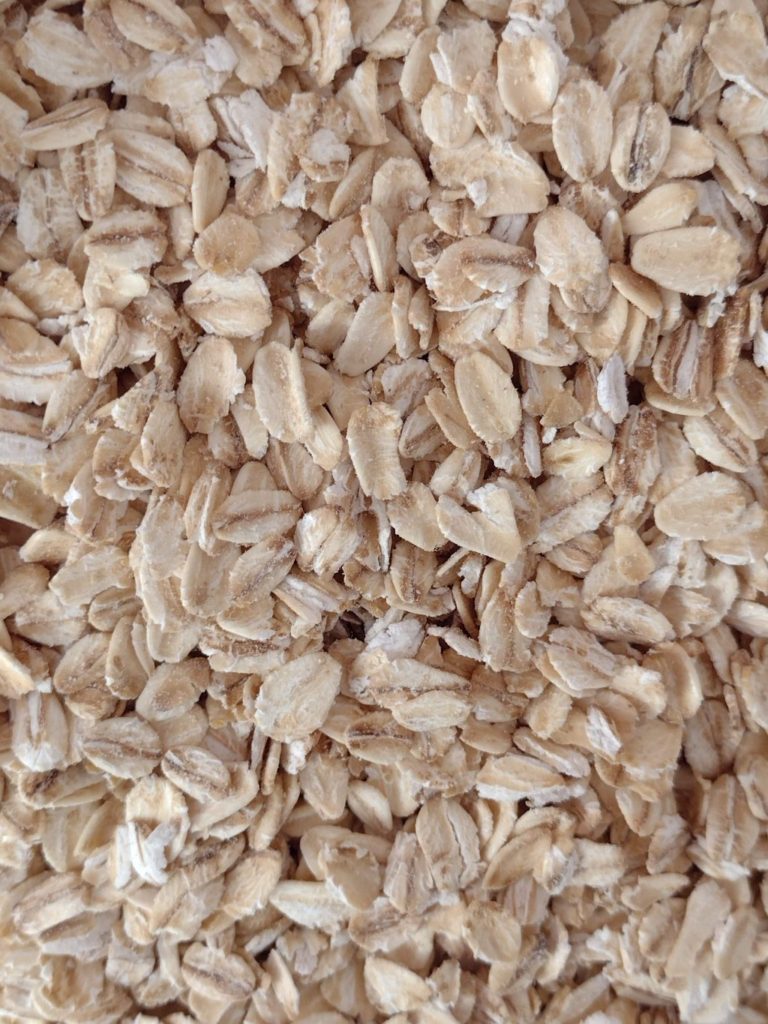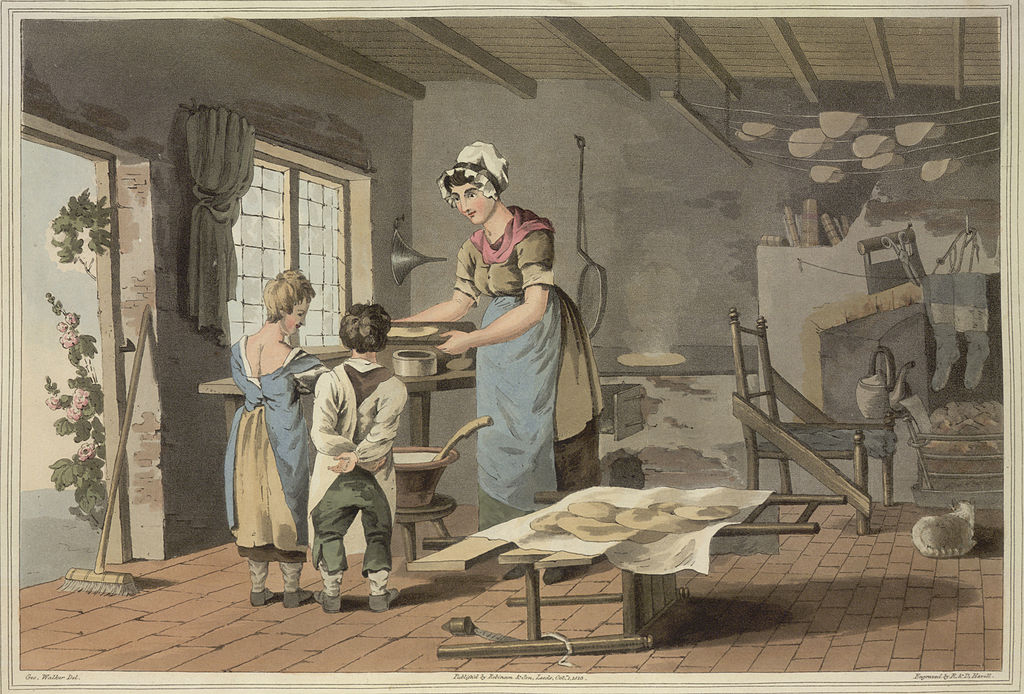This series of posts will explore Welsh food culture, as it developed from the time of the earliest written records through to the 20th century. Much has changed in the last 50 years, so that only vestiges now remain of ways of growing, preparing and sharing food that had previously united much of the country in a shared dishes and culinary cultures. But though the past may be a foreign country, it contains much that is of interest, and perhaps of value…
Early spring – March – in Wales is accompanied by a slow, gentle uptick in temperature and noticeably stronger daylight. By mid-month, one of the most important days in the annual calendar had arrived: Ffair Garon on the 15th, and the right time to sow oats. With the field ploughed and ready, the oats were broadcast, and slowly grew through the lengthening days for a crucial harvest as summer turned to autumn. Because oats can lay claim to being the most important of all Welsh crops – and ingredients – until the second half of the 20th century. Around the oat an entire culture grew.

Oats are enjoying a bit of a renaissance today. The health benefits of oats are being widely lauded, with this once staid and old-fashioned peasant foodstuff now the core ingredient in bircher mueslis, cinnamon porridges and the multi-million dollar oat milk industry. In one sense, the newfound popularity of oats would have been no surprise to generations of Welsh, Scots, Irish and others living on the Atlantic fringes of north-western Europe. Oats are a versatile grain, and in the same way that entire food cultures grew up around rice, maize or wheat (think rice wine and paddies, tortillas and polenta, pies and pasta), oats as a staple can provide the basis for much more than simply breakfast porridge.
Oats (ceirch) were ubiquitous in Welsh food from the earliest records until the 20th century. It’s hard to convey just how much in the way of oat-based foods was consumed, particularly by people living in the western, windward side of the country. Oats found their way into bread, cakes, milk dishes (similar to porridge), broths, drinks and even sandwiches. Unsurprisingly there developed an array of traditions around preparing, storing and using oats with particular implements and a specific vocabulary associated with them.
Oatcakes
Oatcakes (bara ceirch) – round flat cakes made on bakestones – were one of the workhorses of the diet, depended on as a staple food in much of the country, from the hills of Glamorgan up to Snowdonia. They were used neat as an accompaniment to veg in a hot dinner, as a replacement to slices of bread and even as the filling for sandwiches in parts of North Wales.
The thing about oatcakes is the skill required in making them. Because oats don’t contain gluten, a mixture of oatmeal and water won’t form a workable dough in anything like the same way wheat or rye will. There were different traditions of making oatcakes, with variations around adding extra fat to the mixture (dripping or lard) or not and how to roll out the cakes. Suffice to say, the versions without the extra fat take considerable skill, and are crumblier even when well made. But in essence in both versions, water and oatmeal are mixed together to form a stiff dough, which is kneaded. This is turned out onto a surface sprinkled with dry oatmeal, and made it into cone shapes. These are then flattened – either with a rolling pin or with the palm of the hand – until you have a large, thin oatcakes ten inches in diameter. This is baked on a moderately hot bakestone until it turns golden, and then hardened further in a warm place.[1]

With a good store of these, the larder was full for the week and the staple ingredient for numerous dishes was ready. One of the most intriguing of these is an example of a traditional Welsh streetfood, Cocos a Wya. Here eggs and cockles were fried together with a pinch of salt and pepper. Some people added cuts of bacon too. This mixture was then served hot between slices of oatbread. In some coastal areas of northern Wales these were available to buy on the street or at the markets along the coast. A rhyming ditty hailed the availability of this snack:
Cocos a Wya, Bara Ceirch tena,
Merched y Penrhyn yn ysgwyd eu tina!
[‘Cockles and eggs, thin oatbread sliced
The Penrhyn girls’ butts looking nice’]
Note the reference to the oatcakes being thin – that was a mark of a good oatcake in this now-vanished food culture, and was a sure sign of the baker’s skills. There were other oatcake dishes too: picws mali, brwes, siot, and for these the oatcakes are crushed and then combined with buttermilk or beef broth to create further possibilities.
Many of these traditions of making and using oatcakes, along with numerous other oat dishes (which may form the basis for a future piece) survived into the 1980s and 1990s, before dying out with the last generation of women who had been raised in this culture.
Oat implements
The differences that arose even for a procedure as basic as making oatcakes have already been mentioned, and they are symptomatic of the omnipresence of oats in most Welsh kitchens for thousands of years. Around this a range of specific implements were developed, with their own particular purposes and uses. Staying with the oatcake theme, one of these is a drying or storage rack for oatcakes, not dissimilar to a toast rack, called car bara ceirch or diogyn. These were handcrafted, made of wood and a distinctive feature of many Welsh kitchen spaces. See the image here from 1964 for a lovely example. When placed or hung in the hearth at a suitable distance from the fire, they were useful as a location to put oatcakes fresh from the griddle that still needed drying and hardening – away too from curious childrens’ fingers!
Another implement, which goes by various names, was the crafell or rhawlech, a sort of spatula or turner used on the bakestone. These had particularly long, thin blades used for turning the oatcakes as they cooked and varied in size and design from craftsman to craftsman. They were also used for turning the numerous other baked goods prepared on griddles in Welsh kitchens until the middle of the 20th century – breads, welsh cakes, pikelets and more.
The quantity of oats consumed in the course of a year, particularly in more mountainous regions where other grains yielded poorly, called for a proper way to store them. Enter the Cist styffyliog or Oatmeal chest (and see here). In a touch of vernacular space-saving genius, the lids of these store chests were often removable, and could be used as hand barrows. These hand-made pieces of furniture, centuries old, now command several hundred pounds at auction, which is only right considering the care and effort that went into them.
But perhaps the most evocative of these oat-food implements goes by the names wtffon, myndl or pren llymru. Like a slender wooden spoon, with only a narrow bulge at the head, this was used not only to stir llymru – a thin, oatmeal dish borrowed in English as flummery – but also to test its consistency. When the mixture forms a thin ribbon or tail and runs smoothly back into the pan from the stick, as the stick is held the right distance above the saucepan, the llymru was ready. Poor llymru in a household had consequences; word would get around and farmhands would stay away.
‘Ceirch du’
The Welsh oat traditions, like so many other Welsh food traditions, have come close to total extinction. But the links with the past have been maintained by a few thin threads; enough to form for the basis, perhaps, for a future revival. For one thing, as mentioned, many of these dishes and preparation methods were still practiced within living memory, and a great many people in Wales today will not only have strong recollections of eating these oat dishes, but also of how to make them. And beyond this, a small number of farmers kept the tradition alive, growing oats on their farms throughout the 20th century, in the teeth of government guidance and industry recommendations.

One such farmer has kept the tradition of growing the local black oats going on his farm into the 2010s. In addition, far-sighted plant scientists at Aberystwyth University ensured that a significant number of Welsh oat varieties were kept in a seed bank there, awaiting rediscovery. The full story is told in this touching film, and this article. These local oat varieties, in all their genetic diversity, were selected and grown over the full range of Welsh soils and climatic conditions, and produced a staple crop in sometimes difficult growing conditions. With subtle but perceptible differences in flavour, use and growth habit, these Welsh oat varieties could form the basis for a rediscovery of oats in the Welsh diet. There always was more to this grain than just porridge (uwd).
[1] NB This takes practice and patience to get right, and the extra fat from using lard, dripping or butter makes the job easier on an initial attempt. See Tibbot, Welsh Fare, for detailed descriptions and images of various traditional methods, of which there are a selection here.
